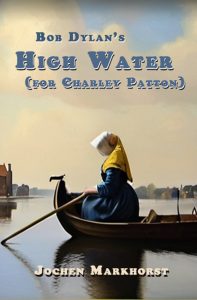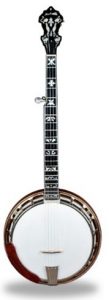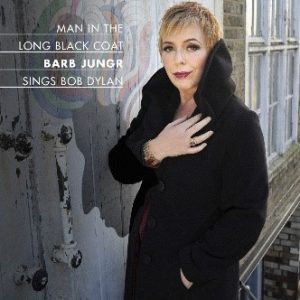 “Maybe you noticed that most of my songs are traditionally rooted. I don’t do that on purpose. Charley Patton’s 30’s blues has made a deep impression on me and High Water (for Charley Patton) is, in my opinion, the best song of this record,” says Dylan at the Rome press conference, July 2001.
“Maybe you noticed that most of my songs are traditionally rooted. I don’t do that on purpose. Charley Patton’s 30’s blues has made a deep impression on me and High Water (for Charley Patton) is, in my opinion, the best song of this record,” says Dylan at the Rome press conference, July 2001.
I do agree. Well, ex aequo with “Mississippi”, anyway. Both songs open the floodgates (no pun intended), and “High Water” belongs in the same outer category as “Desolation Row”, “Mississippi” and “I Contain Multitudes”; extremely rich, poetic, Nobel Prize-worthy musical gems. Lovely, lovely song.
(English, German and Dutch)
High Water (for Charley Patton) (2001) part 25
by Jochen Markhorst
XXV 653 10th Avenue, Hell’s Kitchen, Midtown Manhattan
 Although the song is dedicated to Charley Patton, it is not a blues. Dylan chooses a peculiar, surprising setting for his ode. “High Water (For Charley Patton)” floats on only one chord, a G major (plus a short F – F# lick in each chorus line, signalling despondency), the arrangement is carried by Campbell’s banjo, drummer Kemper limits himself to dramatic thunderous accents (swelling roll with reverb on the upright tom, ominous rustle on the cymbals), the rhythm section consists of Augie Meyer’s neurotic, asthmatic accordion and Kemper’s shaker, and most undylanesque of all is the backing vocals; unearthly and low humming, only in the chorus line, and mixed quite far back – but it’s still there.
Although the song is dedicated to Charley Patton, it is not a blues. Dylan chooses a peculiar, surprising setting for his ode. “High Water (For Charley Patton)” floats on only one chord, a G major (plus a short F – F# lick in each chorus line, signalling despondency), the arrangement is carried by Campbell’s banjo, drummer Kemper limits himself to dramatic thunderous accents (swelling roll with reverb on the upright tom, ominous rustle on the cymbals), the rhythm section consists of Augie Meyer’s neurotic, asthmatic accordion and Kemper’s shaker, and most undylanesque of all is the backing vocals; unearthly and low humming, only in the chorus line, and mixed quite far back – but it’s still there.
The whole communicates implacability, hopelessness. Or, as English musicologist Tony Attwood articulates on his site Untold Dylan:
It is the music, that resolute use of just one chord, that unchanging banjo, that playing around with the melody, and that absolute sense that tells me that no matter what, it is NOT going to stop raining, and that everyone is doomed.
(High Water, a rise, a fall, a bounce, a flood, 23 November 2023)
Bob Dylan — High Water live in Philadelphia, 2001:
The first live performances in 2001 – the premiere is Los Angeles, 19 October – are still fairly faithful to the studio version. Campbell’s banjo is leading (Olof Björner’s unsurpassed website bjorner.com calls it a mandolin, but it’s really a banjo), the only notable difference is the much more prominent drum accompaniment; David Kemper thumps along on his bass drum every beat during the first verse, then joins in energetically like a “regular” rock drummer, and remains very much present, the rest of the song. And the live renditions last a lot longer than the four minutes of the studio version: usually more than six minutes. The tempo is only very slightly slower, but Dylan leaves more space between verses – usually Charlie Sexton plays a short solo after the third verse, often partly in duet with Dylan’s guitar.
In the following years, the banjo briefly disappears from the arrangement and the stage. By 2003, “High Water” has become a taut, funky rocker, including a Little Feat-like interlude spotlighting duelling guitarists Freddie Koella and Larry Campbell. Dylan has moved to an almost inaudible keyboard. In 2004, the song begins to sound like Keith Richards and Ron Wood have joined the band; the guitars get nastier and more obtrusive, the song trashier. But a year later, in 2005, Donnie Herron joins the band, and with him the banjo returns. Initially, this leads to an attractive but somewhat peculiar mix of dirty funk rock with bluegrass, but gradually the arrangement shifts back to 2001. The drums continue to thrust, but the guitars become more civilised, Dylan’s organ forces its way to the fore, and by 2013, when “High Water” is on the setlist more than eighty times, it’s already almost completely turned back to hillbilly; Herron’s banjo is up front, Dylan happily honks along on his harmonica, and when, during the so-called AmericanaramA Festival Of Music Tour in the summer months, Colin Linden is on stage playing slide on his dobro guitar, the return to bluegrass is complete. Well, to rural country rock anyway.
Apart from the occasional outing, such as in 2016, when he suddenly casts the song in the banjo-less corset of Warren Zevon’s “Boom Boom Mancini”, Dylan remains a fan of the more rustic banjo-driven performances in the 300-plus performances since 2013.
The colleagues are not too eager to cover the song. After all, it is quite a challenge, this monotone setting under those wildly fanning lyrics – similar in that respect to the equally untouchable “It’s Alright, Ma (I’m Only Bleeding)”, which its peers also shy away from. Not considering the usual tribute artists, who generally produce lacklustre covers of the song (Big Brass Bed is the exception), there are only two Premier League artists who put “High Water” in their repertoire. Ladies, both of them.
 Barb Jungr is the most remarkable. The Englishwoman with jazz blood already has a solid reputation as a Dylan interpreter (according to the Village Voice , “one of the best interpreters of Bob Dylan”) when she releases her first Dylan album Every Grain of Sand: Barb Jungr Sings Bob Dylan in 2002, which includes one of the very best “Is Your Love In Vain?” covers. Its success, and the constant inspiration she continues to find in one Dylan song after another (“Once I had started singing Dylan’s songs I couldn’t stop”), yields another highlight in 2011: her second Dylan tribute album Man In The Long Black Coat. Thirteen songs, mostly usual suspects like “Just Like a Woman”, “It Ain’t Me Babe” and “Blind Willie McTell”, but also a few outsiders. “Sara”, for instance, and “Trouble In Mind”. And “High Water (For Charlie Patton)”, an interpretation as idiosyncratic as her spelling of the Patton’s first name. It is a dramatic, very European jazz interpretation, carried by a compelling lick from the double bass, expressionistic touches from the piano and soundtrack-like guitar commentary. Whether it can withstand comparison with Dylan’s original is debatable – but at least it is idiosyncratic.
Barb Jungr is the most remarkable. The Englishwoman with jazz blood already has a solid reputation as a Dylan interpreter (according to the Village Voice , “one of the best interpreters of Bob Dylan”) when she releases her first Dylan album Every Grain of Sand: Barb Jungr Sings Bob Dylan in 2002, which includes one of the very best “Is Your Love In Vain?” covers. Its success, and the constant inspiration she continues to find in one Dylan song after another (“Once I had started singing Dylan’s songs I couldn’t stop”), yields another highlight in 2011: her second Dylan tribute album Man In The Long Black Coat. Thirteen songs, mostly usual suspects like “Just Like a Woman”, “It Ain’t Me Babe” and “Blind Willie McTell”, but also a few outsiders. “Sara”, for instance, and “Trouble In Mind”. And “High Water (For Charlie Patton)”, an interpretation as idiosyncratic as her spelling of the Patton’s first name. It is a dramatic, very European jazz interpretation, carried by a compelling lick from the double bass, expressionistic touches from the piano and soundtrack-like guitar commentary. Whether it can withstand comparison with Dylan’s original is debatable – but at least it is idiosyncratic.
American Joan Osborne stays closer to the source and to Mississippi on her tribute album(Songs Of Bob Dylan, 2017). More dynamic, faster and, well, more exciting than Dylan, though its hypnotic nature is still maintained, including through subtle use of a sitar, remarkably. Osborne does sneak in some extra chords, and adds artificial suspense with a stillness halfway through, as well as having a drummer who knows how to work towards a climax – so she does cheat a bit. She is forgiven; the cover is cool and catchy. As are more of the 13 covers on the album, by the way – even “Rainy Day Women #12 & 35” gets cool, swampy and sultry with Joan. And otherwise she opts for the “simply gorgeous” approach , as with “Buckets Of Rain”. Joan Osborne is a pretty bird, she warbles as she flies.
